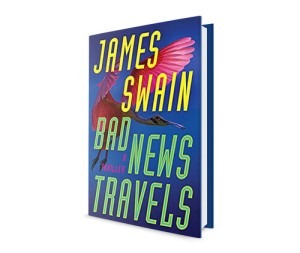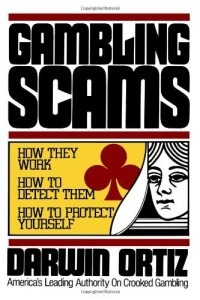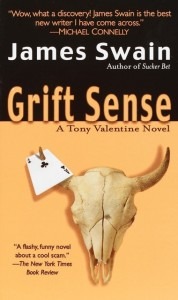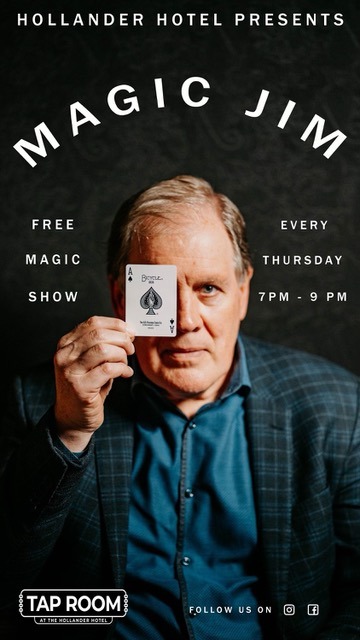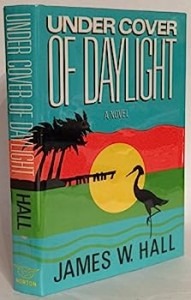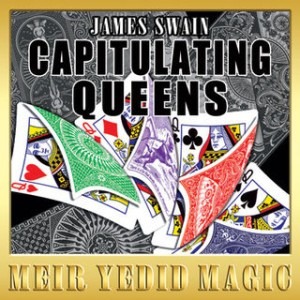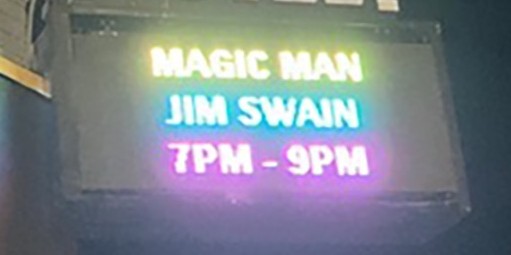
Question
What do you get when you mix mystery and magic?
Answer
James Swain
By Margo Hammond
A best-selling Florida writer, James Swain has earned a slew of awards for his mysteries. His series (he has six of them) follow the exploits of a magician (Vincent Hardare), an ex-cop from Palm Harbor turned private eye (Tony Valentine), an ex-cop from South Florida turned child rescuer (Jack Carpenter), a psychic who sees the future and helps prevents crimes (Peter Warlock), a scammer (Billy Cunningham) and, in his latest, an ex–Navy SEAL who teams up with a FBI agent to find missing persons (Jon Lancaster and Beth Daniels).
Swain is also a magician. For the past nine years (except during pandemic lockdown) he has driven from Odessa to St. Petersburg to offer free magic shows at the Hollander Hotel on 4th Avenue N. You’ll find him there every Thursday from 7-9 pm–just look for the plaque that says Magic Jim on a table in the Tap Room.
Earlier this summer I went to the Hollander an hour before his show to talk to Swain about this double life as a magician and a mystery writer. We sat on a couch side by side, just beyond the bustle of the Tap Room.
The cozy spot reminded me of The Study from the game of Clue, with flames from a fireplace lighting up a chandelier overhead. As we talked, I half expect a man smoking a pipe and wearing a trench coat to emerge from the old-fashioned telephone booth a few feet away.
Mystery and magic, it turns out, constantly overlap in Swain’s life.
“An awful lot of people who come to the Hollander to see my magic show have read my books and that’s a lot of fun,” says Swain who still has the boyish grin I remember when I first met him after the publication of his first mystery in 2001. “They come here and I talk to them about my books. People pull lines from books that I’ve totally forgotten about.”
That's understandable. Swain has written 24 books–including a book on magic called 21st Century Card Magic.
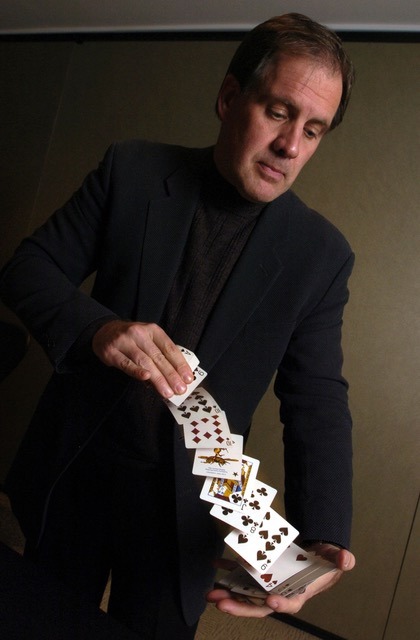
His readers may come at first to meet James Swain, the writer. As Colette Bancroft, the book editor of the Tampa Bay Times once told Swain, “You must be the most accessible writer out there.” But, like me--even if they didn't think they even liked magic, they leave as fans of the art, blown away by Swain's eye-popping show.
Swain specializes in what is known as close-up magic, a sleight-of-hand performance for a handful of people seated at a small table. During his shows Swain keeps up a constant banter, weaving tales and telling jokes as he asks you to pick a card, any card.
Then he dazzles you with a mind-bending trick involving the disappearance and reappearance of that card, leaving you slack-jawed. On occasion, he even makes baseballs vanish and reappear before your very eyes.
“When I started to do magic, a professional magician said to me, ‘You’re a storyteller. All of your routines tell a story,’” says Swain who began telling stories as a child to overcome his shyness. A favorite trick of his wife Laura actually begins just like a story: It's called Once Upon a Time.
“Mysteries prey on preconceived notions,” says Swain. “Magic does that, too. I do it all the time in my show. Writers do it all the time in writing. You take what people have as a certain order of things and you turn it upside-down.”
Now you see the card, now you don’t. Oh, there it is under the magic cup. How did he do that?
Like with a good mystery, it was right there in front of me and yet I didn’t see it. Both mysteries and magic involve a certain degree of distraction, but we want it to be artful distraction. We enjoy being thrown off by red herrings in a mystery and are delighted by the reverses that Swain pulls off in his tricks, but we want the twists to be earned.
“There’s an expression—it’s fun to be fooled,” says Swain. “No it’s not. It’s not fun to be fooled. It’s fun to be entertained.”
For Swain, which came first, the magic or the mysteries? “The magic,” says Swain without hesitation.
“I was doing magic when I was ten. I started performing magic for money with my brother when I was 13, I think, and Tom was 16. We’d go to magic conventions together. Once Tom won the senior competition and I won the junior competition, pretty much doing an identical act – sleight of hand – but he was left-handed and I was right-handed so they looked very similar but they knew it wasn’t the same guy.
“We got these big bowling trophy awards. We were getting some renown as magicians, making good money.”
Then Tom went off to college and left magic behind. Swain, on the other hand, really “jumped into” it. And magic eventually fueled his career as a mystery writer.
“To me, I wouldn’t have one without the other,” he says.
Thanks to magic, he became an expert in casino scams and cheating, a subject that would inspire his early mysteries. “In the ’70s when I was living in New York, the cheats would come into the magic shops and I’d meet them. Because of my prowess with sleight of hand, I would show them something and fool them and then we’d start talking.”
He also learned about scams from fellow magicians like Darwin Ortiz, who worked as a consultant for casinos to prevent cheating there. “I knew Darwin very well. I stayed with him one week during a train strike. He let me stay in his home out in Brooklyn. And that’s all we talked about.” In 1984 Ortiz wrote Gambling Scams, the first book on cheating in casinos.
Casino scams became Swain’s first writing “hook.”
“With writing, you have to have a hook. You better have a hook. Now I had a hook,” says Swain. “So I wrote this book called Grift Sense. I had heard about this thing where people in the casino industry could spot a scam by smelling that something wasn’t quite right about the way people were behaving. A lot of it was little stuff.”
Like the time a casino detective caught a man on tape celebrating immediately after he won a slot machine jackpot. That, it turns out, is a sure tell.
“When people win a jackpot there’s normally a six- or seven-second delay because they’re so used to losing,” explains Swain. “They’ve played thousands and thousands of times so the win doesn’t register at first. But this guy reacted right away.” A cheater nailed.
Stories like that made their way into Swain’s first successful mystery series starring Tony Valentine, an ex-cop who is hired by the Las Vegas casinos to catch cheaters (Atlantic City casinos were his beat as a cop). Published in 2001 to great acclaim, Grift Sense put Swain on the mystery writer’s map.
Swain wrote eight more Valentine books, one every year, with the last two (Jackpot and Wild Card) appearing in 2010 as e-books. Wild Card is actually a prequel to the whole series.
In 2015 Swain launched another series involving casino scams, this time featuring a protagonist who was not trying to catch casino scams, but was pulling them off. Introducing master grifter Billy Cunningham from Providence, Rhode Island, who lived by a “cheater’s moral code,” the series began with Take Down, followed by Bad Action (2016) and Super Con (2017). A fourth Billy Cunningham book is currently in the works, says Swain.
Not all Swain’s series have involved casino scams. He eventually found other “hooks.” In his latest series, set in Florida, ex-Navy SEAL Jon Lancaster teams up with FBI agent Beth Daniels to hunt down missing persons.
For Daniels, the hunt is personal--she was abducted as a child herself. For Swain, the series is personal. His mother was abducted when she was seven--by her own mother. Her parents were divorced. She was living with her dad on Long Island in a little schoolhouse at the height of the depression in the 1930s when suddenly her mother showed up and took her to New York.
She didn’t see her father or her brother or her friends for several years. Then just as abruptly her mother sent her back.
“I didn’t know this history until I went up to see my folks and we drove down to Stonybrook which is where this all took place,” he says. “My mom was in her 70s–I was in my late 30s, early 40s.”
Swain’s mother also was the inspiration for Mabel, Tony Valentine’s feisty Palm Harbor neighbor, one of my favorite Swain characters. “She’s got an opinion about everything, kinda based on my mom,” says Swain.
As a child, Swain was a voracious reader. At age 7 he read a series of biographies written for elementary school kids. “George Washington Carver. Teddy Roosevelt. By the time I graduated from elementary school I’d read every book in the library,” chuckles Swain, who was born in Huntington, Long Island.
In junior high, he read true crime books like The Valachi Papers by Peter Maas. “We had a lot of mafioso on Long Island. They ran things there. They were part of the fabric.”
No surprise, the first book of fiction that really hooked him was The Godfather — written by Mario Puzo in his Long Island basement.
It was his mom who was responsible for Swain meeting Puzo. When the author was invited to speak at her book club, she gave her son her ticket.
“I remember Puzo saying that the best books were really about something else,” Swain recalls, “and when someone from the audience asked him what The Godfather was about, he said that it was about a boy taking over his father’s business.”
Well, yeah–and a few other things, too, of course. Still, Puzo’s advice makes sense. Those of us obsessed with mysteries know the best ones are not only about plot, but about something else. Like casinos.

“I had a lot of great mentors,” says Swain who started writing short stories in high school. His teacher there was Kitty Lindsey, a published novelist. Later he joined the creative writing program at Hofstra University on Long Island, run by Arthur Gregor, a published poet and editor of Random House, and Sam Toperoff.
“Professional writers would come out and speak to us and Toperoff, who lived in Huntington, had me interview them for the Hofstra paper. I think it was called the Chronicle,” says Swain. “I met Joseph Heller, Kurt Vonnegut, Gerold Frank the biographer who wrote books on Judy Garland and Zsa Zsa Gabor, Cynthia Ozick, E.L. Doctorow and John Gardner.
I’ll never forget that Vonnegut and Heller were both asked the same question — What advice do you give to aspiring writers? And they both gave the same answer–Make sure your first novel sells. This is how this business works. If you start a loser, you’re dead.”
Actually, Swain’s first published novel, a story based on the life of Houdini’s nephew which came out in 1989, didn’t do so well. “It lasted about an hour,” he laughs, “but I don’t count that one.”
In addition to those cheats who bent Swain’s ear in that New York magic shop, Swain also credits a number of fellow mystery writers for kickstarting his mystery career back in the early ’80s. “I was living in South Florida, going to Books & Books and reading all these great books,” he remembers. One of them was Jim Hall’s Under Cover of Daylight.
“I read it in one sitting, couldn’t stop reading it, and then I started reading the guy who wrote Miami Blues, Charles Williford. He had the greatest title of any mystery ever, New Hope for the Dead. I know a lot of writers who were really influenced by that book and him.
“Then I started reading James Crumley—Michael Connelly dedicates a book to Crumley. I was living with my now wife Laura. Crime was everywhere. You picked up the paper and read that down the street they found a head in a bucket. Odd crimes, non-definable crimes.”
With material like that, who wouldn’t become a crime writer?
Writing hasn’t paid all the bills though. With his wife, Swain created a highly successful advertising business (one of his clients was a Puerto Rico casino that banned him from the site when he called them out for cheating – they didn’t drop the account though).
Now at 67 he and Laura are retired. He continues to write, publishing his books on his own terms now, often issuing them as e-books. Laura is still his first reader. “She’s the best editor,” says Swain. “She writes ‘Bullshit’ in the margins and tells me what works and what doesn’t.”
It was Laura who convinced him to put the character of Tony Valentine front and center in his first book (Valentine wasn’t even his name when she read his first draft).
One of Swain’s early mentors was a magician named Bob Elliott. When Elliott died in San Diego County in 2011, the San Diego Union-Tribune ran a glowing obituary of this ” amateur magician,” quoting a friend – “He never accepted money for performing. His favorite line was ‘Amateurs built the Ark, professionals built the Titanic.’ He was a teacher, a giver, he just wanted to spread the joy and the magic.”
Sounds a lot like Swain. As a kid he dreamed of making a living as a magician. Now he does magic not just for money but because he loves it. A magician’s magician, he knows hundreds of magic tricks but he also enjoys inventing his own.
Once he created a card trick called Capitulating Queens and gave it away to a friend whose magic shop was struggling. His friend sold ten thousand of them.
During the pandemic Swain had time to invent more routines and streamline some of his old ones. He Zoomed and talked regularly with magicians across the country, including David Copperfield. “We grew up together,” says Swain. “We started talking a lot about our childhoods, how important our parents were to where we are now. Copperfield has a residency in Las Vegas at the MGM Grand, but during the pandemic his show was dark and I wasn’t working, so we talked a lot.”
During one of their conversations, Copperfield gave Swain some helpful advice on how to decide which tricks to do. “It’s not up to you,” Copperfield told him. “The audience will tell you.”
At seven o’clock, it was time for Swain's next show at the Hollander Hotel–time for him to try new and old tricks on his next audience. I was looking forward to seeing those baseballs appear and disappear like, well, magic. It's my favorite trick. "Yeah, I've been doing that one for 50 years. Everybody loves that one," says Swain.
“When I came here nine years ago and met the owner, I knew it was the perfect place to do magic. It’s unique. People try to hire me all the time to do magic, but the magic’s here.”
NOTE: A version of this piece was originally posted at Arts Coast Magazine on July 11, 2023.
